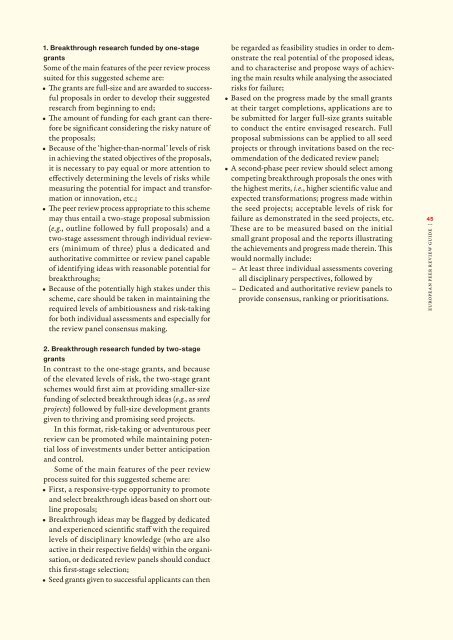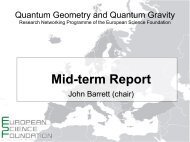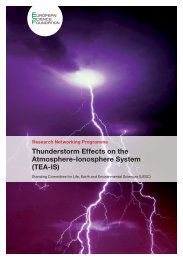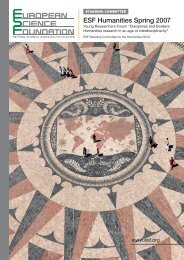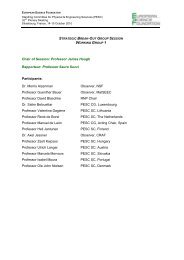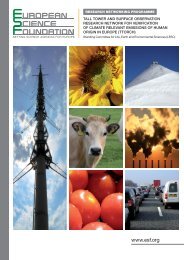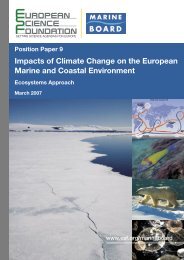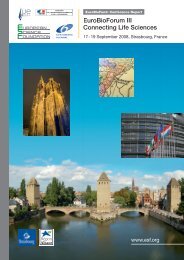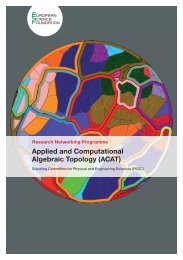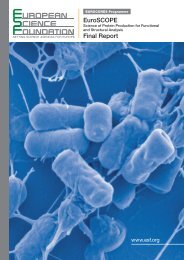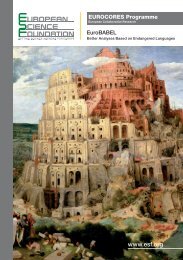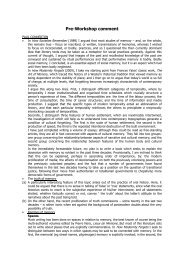European Peer Review Guide - European Science Foundation
European Peer Review Guide - European Science Foundation
European Peer Review Guide - European Science Foundation
You also want an ePaper? Increase the reach of your titles
YUMPU automatically turns print PDFs into web optimized ePapers that Google loves.
1. Breakthrough research funded by one-stage<br />
grants<br />
Some of the main features of the peer review process<br />
suited for this suggested scheme are:<br />
• The grants are full-size and are awarded to successful<br />
proposals in order to develop their suggested<br />
research from beginning to end;<br />
• The amount of funding for each grant can therefore<br />
be significant considering the risky nature of<br />
the proposals;<br />
• Because of the ‘higher-than-normal’ levels of risk<br />
in achieving the stated objectives of the proposals,<br />
it is necessary to pay equal or more attention to<br />
effectively determining the levels of risks while<br />
measuring the potential for impact and transformation<br />
or innovation, etc.;<br />
• The peer review process appropriate to this scheme<br />
may thus entail a two-stage proposal submission<br />
(e.g., outline followed by full proposals) and a<br />
two-stage assessment through individual reviewers<br />
(minimum of three) plus a dedicated and<br />
authoritative committee or review panel capable<br />
of identifying ideas with reasonable potential for<br />
breakthroughs;<br />
• Because of the potentially high stakes under this<br />
scheme, care should be taken in maintaining the<br />
required levels of ambitiousness and risk-taking<br />
for both individual assessments and especially for<br />
the review panel consensus making.<br />
be regarded as feasibility studies in order to demonstrate<br />
the real potential of the proposed ideas,<br />
and to characterise and propose ways of achieving<br />
the main results while analysing the associated<br />
risks for failure;<br />
• Based on the progress made by the small grants<br />
at their target completions, applications are to<br />
be submitted for larger full-size grants suitable<br />
to conduct the entire envisaged research. Full<br />
proposal submissions can be applied to all seed<br />
projects or through invitations based on the recommendation<br />
of the dedicated review panel;<br />
• A second-phase peer review should select among<br />
competing breakthrough proposals the ones with<br />
the highest merits, i.e., higher scientific value and<br />
expected transformations; progress made within<br />
the seed projects; acceptable levels of risk for<br />
failure as demonstrated in the seed projects, etc.<br />
These are to be measured based on the initial<br />
small grant proposal and the reports illustrating<br />
the achievements and progress made therein. This<br />
would normally include:<br />
– At least three individual assessments covering<br />
all disciplinary perspectives, followed by<br />
– Dedicated and authoritative review panels to<br />
provide consensus, ranking or prioritisations.<br />
45<br />
<strong>European</strong> <strong>Peer</strong> <strong>Review</strong> <strong>Guide</strong><br />
2. Breakthrough research funded by two-stage<br />
grants<br />
In contrast to the one-stage grants, and because<br />
of the elevated levels of risk, the two-stage grant<br />
schemes would first aim at providing smaller-size<br />
funding of selected breakthrough ideas (e.g., as seed<br />
projects) followed by full-size development grants<br />
given to thriving and promising seed projects.<br />
In this format, risk-taking or adventurous peer<br />
review can be promoted while maintaining potential<br />
loss of investments under better anticipation<br />
and control.<br />
Some of the main features of the peer review<br />
process suited for this suggested scheme are:<br />
• First, a responsive-type opportunity to promote<br />
and select breakthrough ideas based on short outline<br />
proposals;<br />
• Breakthrough ideas may be flagged by dedicated<br />
and experienced scientific staff with the required<br />
levels of disciplinary knowledge (who are also<br />
active in their respective fields) within the organisation,<br />
or dedicated review panels should conduct<br />
this first-stage selection;<br />
• Seed grants given to successful applicants can then


